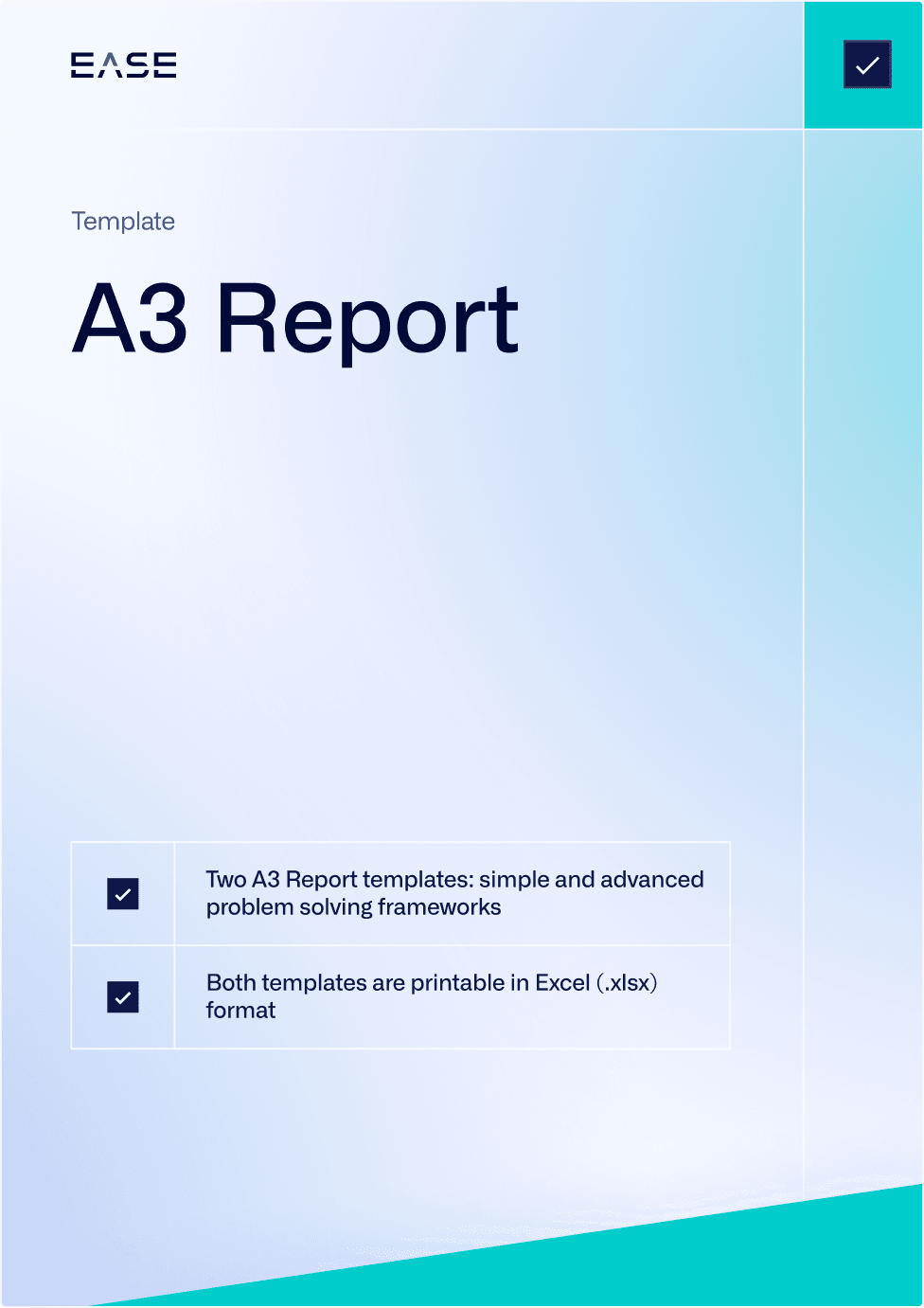A3 Problem Solving Using A3 Report Templates


A3 reports are prevalent in manufacturing, giving teams a way to quickly understand the nature and status of problems affecting their plant.
But how do these reports work, and what lessons can teams learn about maximizing their effectiveness?
This article outlines the fundamentals of A3 report templates, including their structure, common pitfalls to avoid, and essential elements for success.
What Is an A3 Report?
An A3 report is a Toyota Production System tool for communicating the results of the problem-solving process. Named for the blank A3 size paper typically used in this process, A3 reports are a way to document Plan-Do-Check-Act (PDCA) thinking on a single page of paper.
Download Our A3 Report Template
How A3 Reports Support Lean Manufacturing Processes
A3 reports are integral to lean manufacturing and project management strategies, as they provide an organized, in-depth, and visual framework for troubleshooting and continuous improvement (Kaizen).
This report aligns with lean projects and process improvement principles by streamlining processes, reducing waste, and fostering collaboration through detailed documentation of issues and risks, root causes, solutions, and results.
Example of methodologies that use this report:
- Lean Manufacturing
- Six Sigma projects
- Total Quality Management (TQM)
- Kaizen (Continuous Improvement)
- PDCA (Plan-Do-Check-Act)
- Root Cause Analysis (RCA)
- ISO Standards (e.g., ISO 9001)
- Design for Six Sigma (DFSS)
- Problem-Solving Methodologies (e.g., 8D, DMAIC, 5 Whys)
A3 Report Template Structure
The A3 report has a structure similar to 8D problem-solving or DMAIC (define, measure, analyze, improve, control) tools. Diagrams, visual elements, pictures and process flow maps are heavily emphasized in A3 reports; for example, before and after photos of a blemished vs. clean part surface.
While A3 reports vary from one organization to the next, notable template features may include:
- Theme or problem statement:What is the problem you’re trying to solve? The A3 report should succinctly describe the complex problem in one or two sentences.
- Background:This section includes the context and significance of the problem, for example, any relevant customer complaints or photos of defective parts.
- Current state:Here you want to describe the current condition and how it’s contributing to the problem. Value-stream maps or process flow maps are often used to describe the current state, as well as any relevant quantitative data.
- Analysis and root cause identification: This section records the results of the root cause analysis process, for example including a Fishbone diagram or 5 Whys exercise.
- Target state: What is the goal of the process? You should include quantitative goals where possible, as well as any relevant charts or photos of the desired condition.
- Action plan: This part documents proposed actions and the implementation plan for achieving the target state. A proposed timeline is also essential for this section. It may also identify where else the action should be applied to leverage the learning throughout the organization.
- Follow-up actions: Here you want to document any follow-up measures required, such as process audits, to verify conformance with new procedures. Also document any countermeasures not accomplished within the proposed timeline, as well as any problems identified during implementation. Finally, this part should record any results that have been achieved.
Other A3 Report Templates
- A3 Root Cause Analysis (RCA) Report Template
- A3 Value Stream Map Report Template
- A3 Proposal Template
- A3 Strategic Planning Template
- A3 Status Report Template
- And more
Using A3 Problem-Solving Templates
A3 reports aren’t a troubleshooting tool in and of themselves. Rather, they help groups document the thinking process behind how they solve problems. More importantly, the real power of an A3 lies in its ability to communicate the status of troubleshooting efforts—and any bottlenecks in the process.
One of the common uses of A3 reports in fast-response meetings for tracking problems at a plant. Groups may post A3s on flip charts or using a projector. Each group would come up to speak briefly to stakeholders on the status of individual problems currently being addressed and the progress they are making.
For instance, let’s say there’s an A3 team for broken tools. During the meeting, the group lead would point to how they’ve defined the problem including quantifying the problem’s effect on the plant on the A3. They would then go on to explain the solution that was jointly developed with the tool shop to build a thicker tool holder.
The next A3 might deal with paint contamination from fibre in the air. The A3 would document that a new guarding piece is being added to reduce the likelihood of the problem occurring again.
To extend the communication to the frontline workers, some facilities may also post the A3 in specific work areas so everyone knows what’s happening with a recent problem and what they should be paying attention to.
A3 Thinking Pitfalls and Success Factors
In order for A3 reports to provide real value to the organization, two factors must be implemented: regular updating and management involvement.
Groups must regularly review A3s and update them with any new information to keep them relevant. An obsolete or out-of-date A3 will only confuse people, which is why it’s important to look at every step in the process to determine if new information should be added.
Management must also be involved in the process of evaluating and communicating results. If an engineer fills out an A3 and nobody pays attention to it, you won’t get the desired input or result.
For instance, let’s say an A3 report identifies a moulding defect on the left bezel of a part. During the fast-response meeting, management should also ask whether the stock has been checked to see if the defect also exists on the right bezel. Determining where else the problem might occur is vital to leveraging the value of issue resolution and preventive action.
Finally, leadership plays a vital role in keeping the process on track, helping identify and resolve any bottlenecks slowing down the process. For example, the group may need help from subject matter experts (SMEs), more resources to collect data or cross-functional participation of the A3 team.
Using Plant Floor Audits to Support the A3 Process
Plant floor audits such as layered process audits (LPAs) support A3 reporting in several ways. (Read LPA best practices here)
For example, plant floor audit data can illustrate background information on the frequency and location of process failures that cause defects. This information can drive the creation of an A3 team to address the root cause of the issue.
Plant floor audits are also essential for verifying countermeasures and recording progress checks. For instance, an A3 may result in a new LPA question to check that operators are following a new process to ensure finished part surfaces are clean and unblemished. An LPA platform like EASE can streamline this process, helping maximize the value provided by A3 reports. Furthermore, it provides documentation to customers on the effectiveness of the A3, building confidence and trust.
A3 reports communicate troubleshooting at a glance, offering an organized format for describing the problem, its root cause, target state and action plans for improved outcomes. However, organizations must realize that success or failure hinges on the A3 teams regularly updating the form, as well as management asking insightful questions and keeping action plans moving forward.
Plant floor audits, particularly LPAs, complement the A3 process by providing valuable background data, verifying corrective actions and ensuring effective follow-up. This synergy between plant floor audits and A3 reports ensures that companies can get the maximum value for the effort invested in A3 reports.
